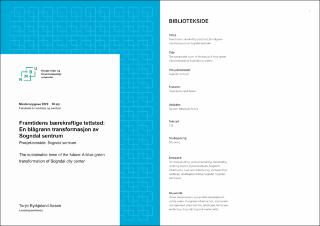| dc.contributor.advisor | Sebastian-Rivera, Agustin | |
| dc.contributor.author | Aasen, Tarjei Byrkjeland | |
| dc.coverage.spatial | Norway, Sogn og Fjordane, Sogndal | en_US |
| dc.date.accessioned | 2022-10-19T15:01:12Z | |
| dc.date.available | 2022-10-19T15:01:12Z | |
| dc.date.issued | 2022 | |
| dc.identifier.uri | https://hdl.handle.net/11250/3027153 | |
| dc.description | Prosjektområde: Sogndal sentrum | en_US |
| dc.description.abstract | Norge urbaniseres, og stadig flere mennesker flytter til norske byer og mindre urbane tettsteder. Med en økende urbanisering, blir det stadig viktigere å planlegge for en utvikling som sikrer levende, attraktive og bærekraftige byer og tettsteder. Kompakt byutvikling og fortetting har blitt viktig i dette arbeidet, og pågår nå for fullt i norske byer og tettsteder. Ukritisk fortetting kan derimot få negative konsekvenser. Forskning viser at flere norske småbyer og tettsteder de siste 30 årene; til tross for en sterk grad av fortetting, har hatt en lite bærekraftig utvikling, med tap av grønne flerfunksjonelle areal og kulturverdier. Dette har ført til negativ påvirkning på biologisk mangfold, rekreasjon og stedsidentitet.
For å utvikle levende, attraktive og bærekraftige byer og tettsteder må man øke tettheten og bygge mer kompakt, samtidig som man tilpasser seg klimaendringen, ivaretar naturmiljøet og sikrer innbyggernes trivsel og tilhørighet. I dette arbeidet vil det bli viktig å skape flere blågrønne byrom med kvaliteter som fremmer byliv, ivaretar stedets identitet og bidrar til klimatilpasning.
Denne oppgaven har tatt utgangspunkt i tettstedet Sogndal med prosjektområde i Sogndal sentrum. Sogndal er et tettsted i sterk vekst, og har et ønske om å fortette og bli en "5-minuttersstad", med et mer levende sentrum. Problemstillingen for oppgaven er: Hvordan kan blågrønne strukturer og stedsidentitet bidra til å utforme levende, flerfunksjonelle og bærekraftige byrom i Sogndal sentrum? Oppgaven vektlegger en kombinasjon av teori og prosjektering, med analyse og utforming av Sogndal sentrum.
Det er hentet kunnskap gjennom studie av relevant litteratur- og dokumenter innenfor temaene by- og byromsutvikling, blågrønne strukturer og stedsidentitet. Gjennom å kombinere den faglige bakgrunnen og en stedsanalyse av Sogndal, presenteres videre en utviklingsstrategi for sentrum. Oppgaven avsluttes med et utformingsforslag som baseres på denne strategien og svarer på problemstillingen. Denne presenteres i en overordna del og en mer detaljert del for et utvalgt område. Prosjekteringen tilsvarer et mulighetsnivå/skissenivå. | en_US |
| dc.description.abstract | Norway is being urbanized and more people are moving to the Norwegian cities and smaller urban areas. With this trend, it becomes increasingly important to plan for a development that ensures vibrant, attractive, and sustainable cities and towns. The development of compact urban areas through densification has been important in this work. However, compact urban development might have two sides. Uncritical densification can have negative consequences. Research shows that several Norwegian small towns and villages in the last 30 years; despite a strong degree of densification, has had an unsustainable development with the loss of green areas and cultural values. This has led to a negative impact on biological diversity, recreation, and place identity.
To develop vibrant, attractive, and sustainable cities and towns, one must densify while at the same time being able to adapt to climate change, ensure the natural environment and the well-being of the inhabitants. In this case it will be important to develop more public spaces with urban blue and green qualities, that promotes urban life, place identity and climate change adaption.
This issue is based on a casestudie the town of Sogndal and focuses on the design of Sogndal city center. Sogndal is a town with strong growth and has a desire to densify and become a compact "5-minute town", with a more vibrant city center. The issue for the thesis is: How can blue-green structures and place identity contribute to designing living, multifunctional and sustainable urban spaces in Sogndal city center? The thesis emphasizes a combination of theory, with analysis and a design proposal.
The theoretical part of this issue is based on relevant literature and documents within the topics of urban development and public spaces, blue-green structures, and place identity. The theoretical part is combined with a site analysis and results in a strategy for further development. By using this strategy, the case study concludes in a design proposal for Sogndal city center. This is presented as a feasability study/sketch-project with a masterplan for Sogndal city center, and more detailed plans for a selected area. | en_US |
| dc.language.iso | nob | en_US |
| dc.publisher | Norwegian University of Life Sciences, Ås | en_US |
| dc.rights | Attribution-NonCommercial-NoDerivatives 4.0 Internasjonal | * |
| dc.rights.uri | http://creativecommons.org/licenses/by-nc-nd/4.0/deed.no | * |
| dc.subject | Tettsteder | en_US |
| dc.subject | Stedsutvikling | en_US |
| dc.subject | Bærekraftig utvikling | en_US |
| dc.subject | Overvannshåndtering | en_US |
| dc.subject | Landskapsarkitektur | en_US |
| dc.subject | Landscape architecture | en_US |
| dc.subject | Sustainable development | en_US |
| dc.subject | Public space | en_US |
| dc.subject | Stormwater management | en_US |
| dc.title | Fremtidens bærekraftige tettsted : en blågrønn transformasjon av Sogndal sentrum | en_US |
| dc.title.alternative | The sustainable town of the future : a blue-green transformation of Sogndal city center | en_US |
| dc.type | Master thesis | en_US |
| dc.description.localcode | M-LA | en_US |

